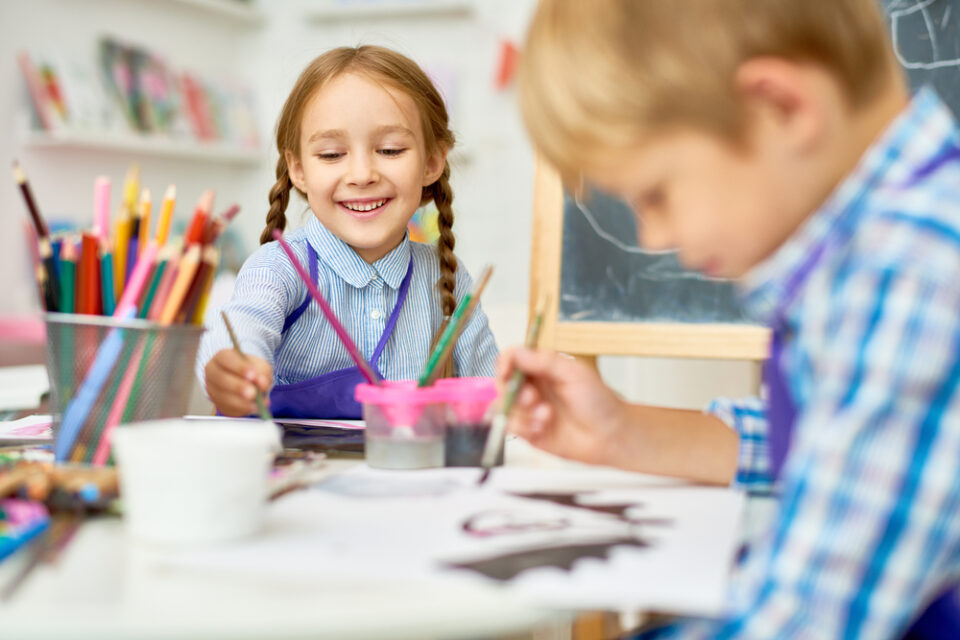Understanding Kids and Creativity
Parents often question if their child is left- or right-brained. Most research states that those who are right-brained are more visual and intuitive. This also includes being creative, free thinkers, artistic and emotion oriented. While left-brained people are typically more analytical, methodical, quantitative and language oriented. According to Harvard Health, “recent research, [shows] the idea of people being ‘left-brained’ or ‘right-brained’ may be less fixed than we’d thought.” This is great news! If you feel your child is more left-brained, which most school subjects focus on, you can still grow and nurture your child’s right-brain growth.
“Beyond the surface where art creation just looks like a fun activity, the process of making art teaches children a variety of crucial skills helpful to being a good citizen in our contemporary world,” says Karen Milito, elementary art and STEAM teacher. “The process of art creation includes higher order thinking skills such as spatial planning, development of symbols, close observation and focus, creative problem-solving and critical reflection.”
The Arts and Development
“Art is all around us, every ‘thing’ is designed and created by someone,” Milito explains. “Our future engineers, marketers and any occupation that develops systems, will benefit from building problem-solving skills as a young person through art.”
Cincinnati Ballet’s Director of Education and Community Engagement, Carolyn Guido Clifford, says you are never too old to take art lessons or engage in art activities.
“It is never too early to start with art lessons. Start young and encourage all kids!” she continues.
Engaging in the arts encourages your child to use their imagination and creativity. It can help improve their fine motor and gross motor skills as well as increase their self-esteem. Long term, engaging in the arts can impact your child in many ways.
“Students that are connected to art in the long term are better collaborators in the workplace. They learn discipline, punctuality, working hard, are more imaginative in their problem-solving abilities, as well as often have an enhanced confidence,” Clifford says.
She also recommends allowing your child to, “feel the freedom to move and express themselves. As well as letting your child tell you what their interest is.”
Encouraging Your Kids’ Artistic Side
Here are some places and things to do that encourage your kid’s creative side and help expose them to the arts at home and in the community. This will not only help them to be the arts maker, but it will also help them to learn to become part of the arts audience and feel comfortable attending a ballet, symphony or visiting a museum.
In the Community
- West Chester Academy; westchesteracademy.com
- Cincinnati Ballet; cballet.org
- Pyramid Hill Sculpture Park & Museum; pyramidhill.org
- Cincinnati Art Museum; cincinnatiartmuseum.org
- Mason Dance Center; masondance.com
At Home
- Mo Willems Lunch Doodles: kennedy-center.org/education/mo-willems/lunch-doodles
- Michaels Kids Club Camp Creatology: michaels.com/campsignup
- Read books about the arts or about artists – check a book out at your local library or use the Hoopla app to explore more books, audio books and more in the comfort of your home.
- Make music with items you have at home
- Turn on music and dance
- Create art with supplies you have at home
Also, take advantage of ways you can showcase your kid’s hard-earned work. The Ohio Department of Education, for example, encourages showcasing your child’s art by asking families to post a photo of their work or a performance video on social media using the hashtag #OhioArtsAtHome.
“Art is a place for children to learn to trust their ideas, themselves, and to explore what is possible.” – Maryann F. Kohl





